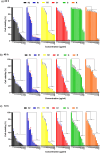Green synthesis of silver nanoparticles from plant Astragalus fasciculifolius Bioss and evaluating cytotoxic effects on MCF7 human breast cancer cells
- PMID: 40664749
- PMCID: PMC12264097
- DOI: 10.1038/s41598-025-05224-5
Green synthesis of silver nanoparticles from plant Astragalus fasciculifolius Bioss and evaluating cytotoxic effects on MCF7 human breast cancer cells
Abstract
Astragalus fasciculifolius Bioss, commonly known as Anzaroot, is a medicinal plant from the Fabaceae family, recognized for its therapeutic properties due to its rich composition of saponins, flavonoids, and polysaccharides. These compounds have been shown to effectively treat heart diseases and inhibit cancer cell growth while also alleviating chemotherapy side effects. Recent research has focused on the green synthesis of silver nanoparticles (AgNPs) from Anzaroot, exploring their potential cytotoxic effects against MCF-7 human breast cancer cells. This study aims to bridge traditional herbal medicine and modern nanotechnology by evaluating the anticancer properties of AgNPs derived from this lesser-explored plant. This study was aimed to assess the cytotoxic effect of Anzaroot and green synthesized AgNPs using aqueous extract of Anzaroot on the MCF-7 cell line. To optimization of AgNPs synthesis, different parameters were evaluated including Anzaroot aqueous extract volumes (1, 2, 3 and 4 ml), silver nitrate solution (AgNO3) concentrations (1, 5 and 10 mM), reaction time (30, 60 and 300 min) and reaction solution pH (2, 4, 6, 8 and 10) at room temperature. Transmission electron microscopy (TEM), Fourier transform infrared (FTIR) spectroscopy, ultraviolet-visible (UV-Vis) spectroscopy, and X-ray diffraction analysis (XRD) were used to characterization of the AgNPs using aqueous extract of Anzaroot-silver nanoparticles (Anz@AgNPs). The obtained Anz@AgNPs exhibited Surface Plasmon Resonance (SPR) centered at 443 nm, with an average particle size calculated to be about 16 nm. The XRD spectrum of Anz@AgNPs showed a face-centred cubic (FCC) crystalline nature. The optimized parameters for successfully AgNPs synthesis were optained as follow: 4 ml aqueous extract volume, 1 and 5 mM AgNO3, reaction time of 300 min, and pH 8. MTT assay demonstrated the remarkable dependent dosage anticancer effect of the Anz@AgNPs against MCF-7 cell line. The IC50 value exposed that The lowest and the highest IC50 values was demonstrated for the Anz@AgNPs synthesized through the root extract (21.73 μg/Ml) and the aqueous root extract (348.21 μg/Ml) treatment. Based on the MTT assay, the Anz@AgNPs showed the inhibition of cell proliferation potential more than the aqueous extract of this plant. The plant organs used in Anz@AgNPs synthesis, root and gum, influenced their anticancer activity; nanoparticles synthesized from root extract demonstrated a stronger growth inhibitory effect than those from gum extract. The results demonstrated that anzroot plant can be effectively used as a reducing agent for AgNPs synthesis, and AgNPs have the potential to be used effectively in cancer therapy methods and to inhibit the growth of cancer cells.
Keywords: Astragalus fasciculifolius (Anzaroot); Anzaroot-silver nanoparticles (Anz@AgNPs); Breast cancer; Cytotoxicity; Silver nanoparticles (AgNPs).
© 2025. The Author(s).
Conflict of interest statement
Declarations. Competing interests: The authors declare no competing interests. Ethics approval and consent to participate: No human or animals were used in the present research. Ethical issues: Ethical issues (including plagiarism, data fabrication, double publication) have been completely observed by the authors. The authors have adhered to ethical standards, including avoiding plagiarism, data fabrication, and double publication. Consent for publication: All authors read and approved the final manuscript for publication. Informed consent: The authors declare not used any patients in this research.
Figures










Similar articles
-
Biosynthesis and characterization of silver nanoparticles from Asplenium dalhousiae and their potential biological properties.PLoS One. 2025 Jun 30;20(6):e0325533. doi: 10.1371/journal.pone.0325533. eCollection 2025. PLoS One. 2025. PMID: 40587502 Free PMC article.
-
Evaluation of Cytotoxic and Antioxidant Potential of Green-Synthesized Silver and Gold Nanoparticles From Nepeta leucophylla Benth.Chem Biodivers. 2025 Jul;22(7):e202402679. doi: 10.1002/cbdv.202402679. Epub 2025 Mar 13. Chem Biodivers. 2025. PMID: 39984311
-
Characterization of Silver Nanoparticles Synthesized Using Hypericum perforatum L. and Their Effects on Staphylococcus aureus.Microsc Res Tech. 2025 Aug;88(8):2321-2332. doi: 10.1002/jemt.24862. Epub 2025 Mar 23. Microsc Res Tech. 2025. PMID: 40121669 Free PMC article.
-
Phytogenic nanoparticles: synthesis, characterization, and their roles in physiology and biochemistry of plants.Biometals. 2024 Feb;37(1):23-70. doi: 10.1007/s10534-023-00542-5. Epub 2023 Nov 2. Biometals. 2024. PMID: 37914858 Review.
-
Cost-effectiveness of using prognostic information to select women with breast cancer for adjuvant systemic therapy.Health Technol Assess. 2006 Sep;10(34):iii-iv, ix-xi, 1-204. doi: 10.3310/hta10340. Health Technol Assess. 2006. PMID: 16959170
References
-
- Saravani, K., Saravani, S. & Dadras, F. Investigating attitudinal barriers to breast cancer mammography screening among women in Zabol city. Cell Mol. Biomed. Rep.1, 158–167 (2021).
MeSH terms
Substances
LinkOut - more resources
Full Text Sources
Medical

